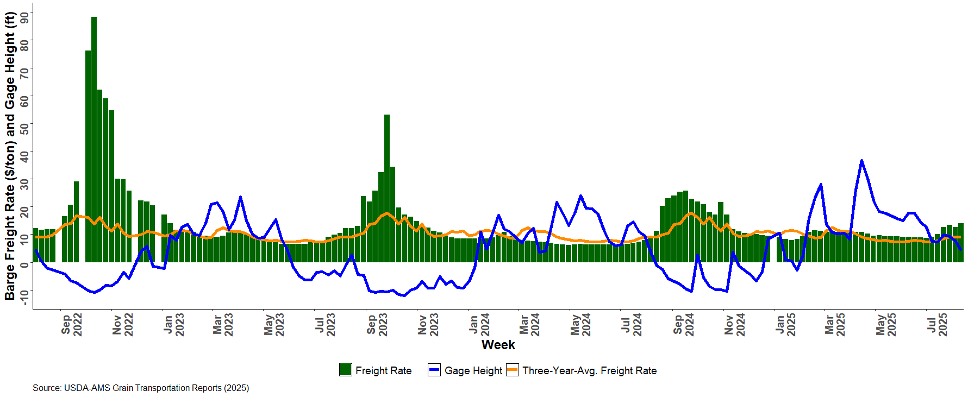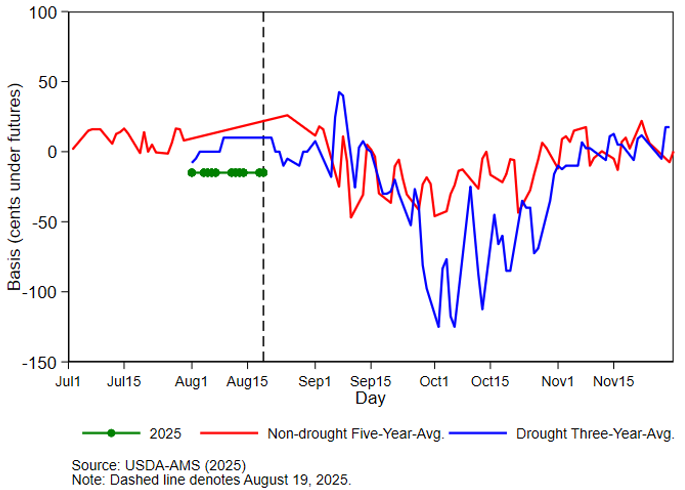The Mississippi River level measured by the U.S. Geological Survey at Memphis, TN, may drop to severe lows for the fourth year in a row (USGS, 2025). The Mississippi River has fallen below the agreed-upon zero reference point of the USGS stream gage during harvest (i.e., August 1 through November 30) eight of the last ten years, underscoring the impacts drought can have on river levels. We discussed what is meant by a river level below the zero reference point in a previous article (Biram, Mitchell, and Stiles, 2024; National Weather Service, 2024). Further, the level has now fallen to the “low” stage, defined by the National Weather Service as -5 feet, five times (2015, 2017, 2022, 2023, and 2024). These historically low river levels carry serious implications for cash basis, or the local cash price offered by a grain elevator less the futures price traded on a global market (Biram and Mitchell, 2025).
Figure 1 plots the Mississippi River level measured at Memphis, Tennessee, for the period August 11, 2022, through August 20, 2025. This figure also provides the weekly average freight, as well as the expected barge freight rate measured by the non-drought three-year average freight rate (i.e., 2019-2021). Barge freight rates are established by the U.S. Inland Waterway System using a percent of tariff system and have been discussed in a prior article (Biram, Mitchell, and Stiles, 2024). Since the 2022 drought event, we have observed that when the gage height falls, barge freight rates increase, and vice versa. However, it appears that barge operators have adjusted as the weekly average freight rate has declined since the drought event of 2022.
Figure 1. The relationship between the Mississippi River level and barge freight rates for moving cargo from Cairo, IL or Memphis, TN (August 2022 – August 2025)

Nonetheless, midsouth soybean basis is not only weaker than the non-drought five-year-average (i.e., 2017-2021) but is also weaker than the average basis observed over the last three drought years (i.e., 2022, 2023, and 2024). Basis can change abruptly due to economic or environmental events, such as low river levels. Changes in basis reflect changes to local market conditions. Local cash bids offered by elevators on the Mississippi River tend to be influenced by river level in periods of drought as described by previous SAT articles (Biram, et al., 2022; Biram, 2023; Gardner, Biram, and Mitchell, 2023; Biram, Mitchell, and Stiles, 2024). This is because it is more expensive to ship the same amount of grain in more loads to reduce barge draft.
Figure 2 shows the soybean basis response to low river levels in Helena, Arkansas in 2022-2024 with current basis for 2025 well below average as of August 20, 2025. The green line in Figure 2 provides the most recent basis for new crop soybeans and is well below both the averages for non-drought and drought years. The dashed vertical line denotes the basis most recently reported (-15) on August 20, 2025, and is 41 cents below the average non-drought-event basis of 26 cents and 25 cents below the average drought-event basis of 10 cents.
Figure 2. Daily Soybean Basis at Helena, AR in Harvest Window

The economic impacts of marketing in this window are clear. Mitchell and Biram (2025) determined that in 2022, alone, Arkansas farmers faced nearly $300 million in losses due to widening basis driven by low river levels, with a similar impact in Mississippi. A potential option farmers might have is to store grain in the bin and market it during the post-harvest window as described in previous Southern Ag Today articles (Gardner, 2023; Gardner and Maples, 2023; Gardner, 2024; Smith, 2024). Historically, futures and basis tend to recover in the months when there is little domestic production to buy, and stocks are drawn down. However, we recognize that not all farmers have the infrastructure in place (i.e., 48% of expected total crop production in 2024 was held in storage (USDA-NASS, 2025a and 2025b)) to store grain and market in the post-harvest window, which has implications for 2025 returns and 2026 loan renewal.
References
Biram, Hunter, John Anderson, Scott Stiles, and Andrew McKenzie. “Low Water Levels in the Mississippi River Result in Abnormally Weak Soybean Basis“. Southern Ag Today 2(45.1). October 31, 2022. Permalink
Biram, Hunter. “Flooding in the Upper Mississippi River is Associated with Relatively Weak Soybean Basis in the Midsouth.” Southern Ag Today 3(21.1). May 22, 2023. Permalink
Biram, Hunter, James L. Mitchell, and H. Scott Stiles. “Low Rivers Levels on the Mississippi River: Not the Three-Peat We Want.” Southern Ag Today 4(39.3). September 25, 2024. Permalink
Biram, Hunter, and James L. Mitchell. “Estimating the Impact of Low Mississippi River Levels on Soybean Basis in the Midsouth.” Southern Ag Today 5(12.3). March 19, 2025. Permalink
Gardner, Grant, Hunter Biram, and James Mitchell. “Low River Levels, Barge Freight, and Widening Basis.” Southern Ag Today 3(39.1). September 25, 2023. Permalink
Gardner, Grant. “Interest Rates and Grain Storage.” Southern Ag Today 3(26.1). June 26, 2023. Permalink
Gardner, Grant. “To Store or Not to Store? Old Crop Exit Strategies.” Southern Ag Today 4(35.1). August 26, 2024. Permalink
Gardner, Grant, and William E. Maples. “River Levels and Off-Farm Storage Disbursement.” Southern Ag Today 3(43.1). October 23, 2023. Permalink
Mitchell, J. L., & Biram, H. D. (2025). The effects of extreme weather on rural transportation infrastructure and crop prices along the Lower Mississippi River. Applied Economic Perspectives and Policy.
National Weather Service. “How can a river stage be negative?” National Oceanic and Atmospheric Administration, National Weather Service. Accessed September 16, 2024. Permalink
Smith, Aaron. “Storing corn or soybeans: what is the futures market incentivizing?” Southern Ag Today 4(33.1). August 12, 2024. Permalink
United States Geological Survey. 2025. Monitoring location, Mississippi River at Memphis, Tennessee. Available at: https://waterdata.usgs.gov/monitoring-location/USGS-07032000/#dataTypeId=continuous-00065-0&period=P7D
USDA-NASS. 2025a. August 2025 Crop Production Report. Available at: https://downloads.usda.library.cornell.edu/usda-esmis/files/tm70mv177/6m313n48h/bk12b9684/crop0825.pdf
USDA-NASS. 2025b. QuickStats Query. Available at: https://quickstats.nass.usda.gov/#E31D1B9E-04B3-3954-939A-273CD6380DF9
USDA-AMS. 2025. Grain Transportation Reports. Available at: https://www.ams.usda.gov/services/transportation-analysis/gtr
Biram, Hunter D., James Mitchell, and H. Scott Stiles. “The Mississippi River is Set to Fall to Severe Levels for the Fourth Year in a Row.” Southern Ag Today 5(35.3). August 27, 2025. Permalink

Leave a Reply